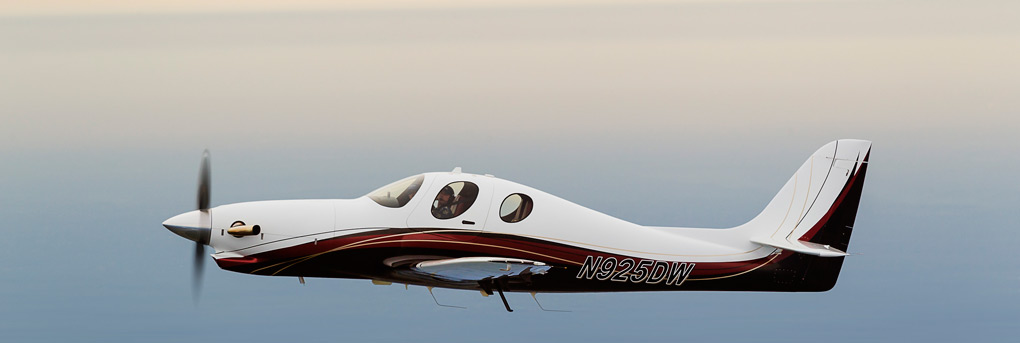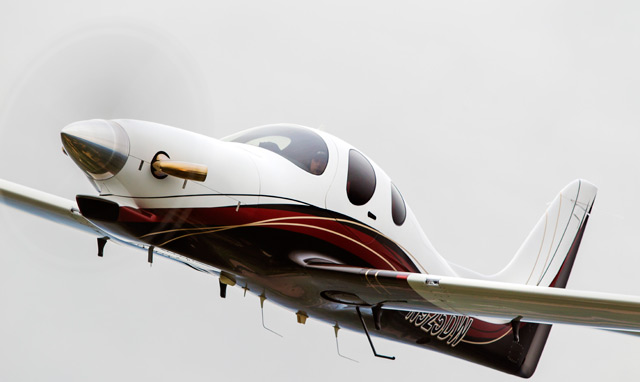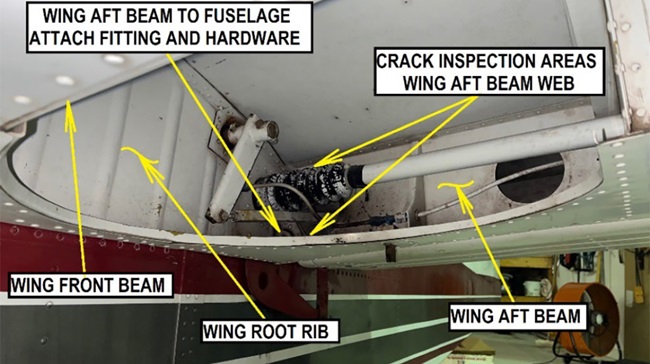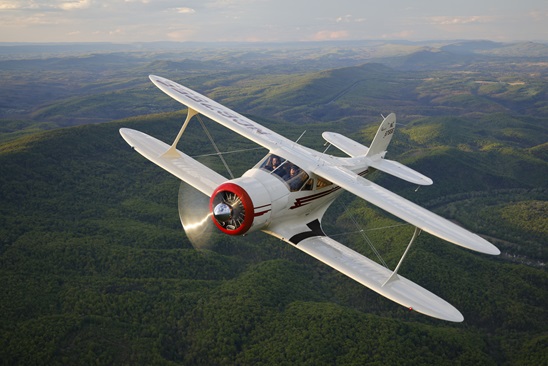
Photography by Mike Fizer
The air traffic controllers couldn’t seem to get the name of Lancair’s turboprop, the Evolution, quite right.
During our short taxi for departure, both ground and local controllers at Cincinnati Municipal Airport Lunken Field referred to the sleek, four-seat kit airplane as “Revolution.”
Cleared for takeoff on Runway 21 Left, Lancair dealer and demo pilot Doug Walker advanced the power lever on the 750-shaft-horsepower Pratt & Whitney PT6A-135A. As the four-blade Hartzell prop bit into the humid air and wisps of condensation swirled from the tips, it occurred to me that perhaps the controllers had it right. This high-flying, 300-knot, carbon-fiber greyhound—with its standardized FAR Part 23-compliant construction, $1.3 million price tag, and mandatory flight test and training programs—is seeking to completely redefine the top end of the Experimental marketplace. And if that kind of rapid, wholesale change isn’t the stuff of revolution, what is?
Walker limits engine power at takeoff to 1,280 pound feet of torque (about 550 shp) so as not to overwhelm the rudder with left-turning P-factor. We’re airborne after a 1,200-foot ground roll and free to add full power. Doing so at VY will result in a maximum rate of climb touching 4,000 fpm, but our goals on this evening flight aren’t that ambitious. We’re simply keeping pace with an IO-550-powered Bonanza A36 that’s serving as photo platform, and the trusty Bonanza is about 15 seconds ahead of us and is climbing at full power and 120 KIAS.
I take over the Evolution flight controls and adjust the power lever as we join the Bonanza. The side-stick controller feels solid and substantial in my left hand and makes fine pitch and bank adjustments second nature. The engine and prop respond immediately to slight power changes and make acceleration and deceleration crisp and immediate.
As we settle into level flight alongside the doorless Bonanza, it’s running hard at 25 inches of manifold pressure and 2,500 rpm. I glance at the Evolution engine instruments to confirm that torque and temperatures are within normal limits. No problem there. The Evolution only needs 28 percent power to match the Bonanza.

A misnomer
Lancair International’s Evolution prototype first flew in 2008 and the Redmond, Oregon, company began selling kits the following year.
The name Evolution implies a steady progression from the company’s existing line of fast, composite, low-wing airplanes, but that’s a misnomer. The Evolution brings major changes from the Lancair IV-P, a pressurized, four-seat kit airplane that some owners have fitted with turboprops (usually the Czech-built Walter 601).
The Evolution was designed to FAR Part 23 construction standards so that FAA certification theoretically is possible in the future. The Evolution’s long, high-aspect-ratio wings have quite a bit more area than the IV-P, and that allows the Evolution to carry more internal fuel and lowers the stall speed to the Part 23 requirement of 61 knots maximum in the landing configuration.
The Evolution build time of 1,500 hours is about half that of a IV-P, and the Evolution construction process requires that builders come to the Oregon factory for a two-week “quick start” program in which all the structural elements are completed under expert supervision. After two weeks, the Evolution is on its gear, the wings are closed, and builders are left to install the engine, avionics, interior, and paint.
The Evolution’s cabin is the same width as the Cessna Corvallis (which started as a Lancair before undergoing multiple design and ownership changes), and the Evolution cabin is 13 inches longer.
Lancair also is going against kit airplane history and culture by doing everything possible to standardize engines and avionics. The PT6A-135A is the company’s engine of choice, and the factory makes sure builders have access to new, overhauled, and used engines—and strongly encourages builders to stick with them. The EFC 900X is a customized version of the Garmin G900X (an Experimental version of its groundbreaking G1000 system). For the Evolution, Lancair and Garmin have brought Garmin’s digital GFC700 autopilot to an Experimental airplane for the first time. The FAA-certified L-3 Trilogy standby instrument makes the Evolution panel all-glass.
Kit aircraft traditionally have been built by hobbyists and sold in bits and pieces. Only a fraction of the kits sold are ever completed. But Lancair is attempting to upend that model with the Evolution, too.
Anyone who shells out more than a half million dollars for a kit has a huge financial stake in completing it. When the kit is finished and ready to fly, the first flight is made by a professional test pilot with Evolution experience—not the builder. There’s also a mandatory flight training program for owners, and professional instructors available to help with the transitions.
Walker had been a Corvallis dealer and pilot before building and flying the Evolution, and says the high-altitude turboprop isn’t a great leap for pilots accustomed to high-performance piston airplanes. (Lancair also offers a piston Evolution with a turbocharged Lycoming iE2 engine at significantly reduced cost, but so far all buyers have opted for turboprop power.)
“In many ways, the Evolution is much simpler than a high-performance piston airplane,” he said. “Once you move the condition lever out of idle cutoff, you never have to adjust it during flight. And once you push the prop forward, you don’t have to touch it again, either. You have to learn some new terms for engine management, but you don’t have to worry about manifold pressure, prop controls, mixture, CHTs, or any of that stuff.”


Obedience and stability
Seeing the Evolution up close, it’s impressive for the extraordinary quality of its fit and finish. The carbon-fiber pieces are built to extremely close tolerances and the baggage and passenger entry doors—and control surfaces—fit with precision.
Smooth, complex curves and rounded windows give the airplane a slightly alien, Rutanesque appearance (the famed designer had nothing to do with it). The elliptical wing is smooth with no rivets, screws, or metal whatsoever.
A step allows access to the top of the left wing, and cabin entry is through a single, top-hinged door on the left side. Stepping down into the left seat requires some gymnastics to avoid stepping on the two-tone leather seats. The seating position is upright and visibility over the thin, down-sloping nose is tremendous. The view out the side bubble windows is very good, too, but a thick post and surrounding support structure create a blind spot between the two. Closing the door is a simple matter of pulling it down and pushing a single lever that locks the frame in place.
Engine start is standard for a PT6, and air conditioning makes the cabin comfortable. Taxi is normal with toe brakes, and programming the EFC 900X is familiar to pilots accustomed to ubiquitous Garmin equipment. With two people aboard, 120 gallons of fuel, and no baggage, the airplane is about 800 pounds under its maximum gross weight of 4,300 pounds.
Acceleration on the takeoff roll is brisk and silky smooth, and we’re airborne at 80 knots and climbing. Short-field takeoff techniques can reduce the takeoff roll to 1,000 feet at standard, sea-level conditions, but Lancair limits takeoff power to 550 shp so that the powerful left-turning tendency doesn’t overpower the rudder. As soon as the airplane is off the ground and the yaw damper engaged, pilots are free to use full engine power. Walker raises the landing gear and flaps and begins a normal climb.
Full power and a best-rate speed of 110 KIAS typically results in a VLJ-like climb rate of 4,000 fpm, but a more sedate 170-knot cruise climb still results in a healthy 2,500 fpm climb. Walker says it typically takes about 11 minutes to climb to 24,000 feet in the real-world ATC system. The airplane is limited to 28,000 feet (with a 6.5 psi pressurization system resulting in a 7,000-foot cabin altitude) because its avionics aren’t RVSM certified. But the airplane is capable of reaching far higher altitudes. Electrically heated Therm-X deicing strips on the leading edges of the wings and horizontal tail provide ice protection for the airframe, and a spray bar sends TKS fluid to the windshield.
Walker typically flies at 28,000 feet and 285 KTAS while burning 35 gph, and that gives a no-wind range of 1,300 nm with IFR reserves. His top speed at that altitude is 300 KTAS at 39 gph, and low cruise is 250 KTAS at 25 gph.
There’s virtually no adverse yaw in 45-degree turns, and the airplane conveys a feeling of both obedience and stability. Heading downhill, the ailerons become noticeably heavier as airspeed increases beyond 200 KIAS. There are no speed brakes—and no need for them—as the four-blade Hartzell prop flattens out and slows the airplane like an anchor.
Walker delights in demonstrating simulated emergency descents in which he puts the prop in flat pitch, points the nose steeply down, and lets the airspeed settle at 110 KIAS with a descent rate of more than 3,000 fpm.
I target 85 KIAS on final approach with the flaps down and power near idle. Touchdown is smooth on the tall, trailing-link gear, and light braking allows for an easy runway exit at midfield. Flattening out the prop or moving to reverse thrust dramatically shortens landing rolls and Walker says he has no hesitation operating from runways as short as 2,000 feet. But he cautions pilots to be prepared to use differential braking for directional control since flat or reverse prop pitch effectively blanks airflow over the rudder during rollout.
Competitive landscape
Although single-engine turboprops such as the Socata TBM 700 and 850, Piper Meridian, and Pilatus PC–12 have gained wide market acceptance in the last decade, and more competition is coming from Kestrel (and perhaps Cessna), the Experimental nature of the Evolution makes it different. It’s a rare pilot/owner with the skill, desire, time, and resources to build his or her airplane—and manage its construction. With the precipitous drop in used aircraft values during the past four years, the Evolution finds itself competing against multiengine turboprops or even multiengine jets in the same price bracket. And, even though the Evolution’s operating costs may be far lower, it also has to compete against the convenience of existing airplanes that are available right away.
But with 26 Evolutions flying and 17 more under construction, Lancair has shown that there are buyers out there who are seeking performance as well as the deep and intimate knowledge of an aircraft that comes from the experience of putting it together. It’s a major commitment and it’s definitely not cheap.
But for the pilot who is looking for exceptional performance and an airplane that he or she will know inside and out, building, owning, and flying an Evolution could be just the right fit.
Email [email protected]



